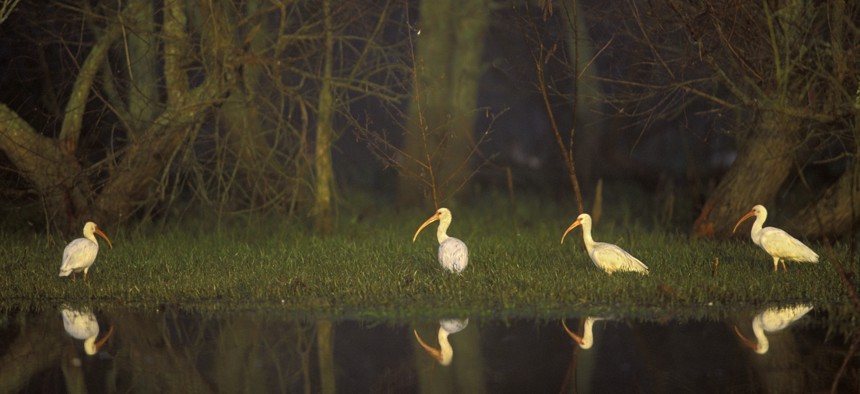New Orleans’ Christmas Trees Get a Second Life

White Ibis at Bayou Sauvage National Wildlife Refuge Bob Sacha via Getty Images
An annual "Christmas Tree Drop" deposits thousands of repurposed trees throughout a Louisiana wildlife refuge to help restore wetlands.
As households across the nation begin taking down their holiday decorations, the residents of New Orleans have a unique opportunity. They have one more chance to share season tidings of comfort and joy—with the critters of a nearby wildlife refuge.
In the coming days, New Orleans residents can choose to donate their Christmas trees to be dropped throughout the Bayou Sauvage Urban National Wildlife Refuge, where the former festive staples will be used to improve wetlands and provide habitats for wildlife.
For more than 20 years, the city has partnered with the Louisiana National Guard and the U.S. Fish and Wildlife Service to give the trees new life in the bayou to help stabilize eroding banks, according to Gregory Joseph, communications director for the mayor’s office. The program began as a graduate student project at Louisiana State University, and over the last two decades, has restored an area equivalent to nearly 200 football fields.
Wetlands are important ecological landscapes that mitigate flooding, store carbon and foster rich and diverse ecosystems. In 2005, Hurricane Katrina ravaged the bayou and destroyed 1,700 acres of fresh and brackish wetlands, according to the U.S. Fish and Wildlife Service.
Today, the donated Christmas trees help restore and stabilize shorelines, according to the city. From there, it's not long until wildlife takes advantage of the new real estate, which provides feeding grounds for fish and attracts waterfowl for nesting. At nearly 30,000 acres, Bayou Sauvage is the second largest urban refuge in the country, according to the U.S. Department of the Interior.
Residents that opt to donate their trees can simply place the trees out on the curb on regular trash collection days between Jan. 7-9 for the city to pick up. In 2019, the city collected 6,000 trees.
The Louisiana National Guard then collects the trees and airlifts them to the Bayou Sauvage refuge, where the trees are dropped by helicopter into the water. Crews on the ground then distribute the trees to their final positions, according to the city, typically along existing banks.
A biologist with U.S. Fish and Wildlife determines where to drop the trees, Joseph said. Because the program has led to significant improvements in the areas where trees were previously distributed, crews are able to focus on new sections of the refuge each year.
Molly Bolan is the assistant editor for Route Fifty.
NEXT STORY: The New Federal Grants to Help Cities Ditch 'NIMBY'-backed Zoning






